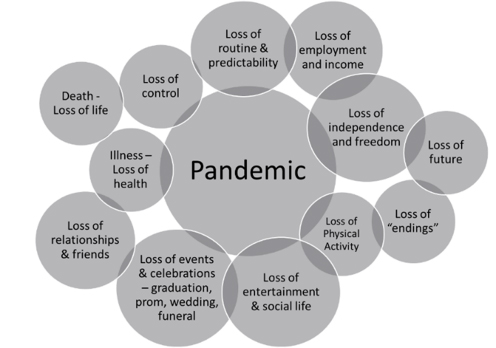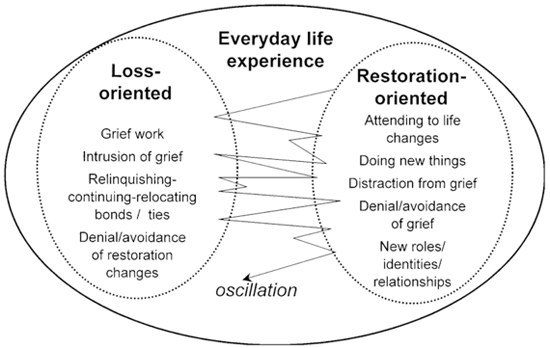Web Exclusive
Uncertain Times — Coping With Loss During the COVID-19 Pandemic During the unprecedented COVID-19 pandemic, individuals are experiencing multiple losses. Thousands of people have died as result of the virus and this pandemic has changed nearly every part of our lives. Not only do we stand to lose loved ones, under complicating circumstances, but we also are facing a loss of a “conventional reality” (Association for Death Education and Counseling, 2020a). A collective loss of normalcy and fear of future disruptions has left many experiencing reactions frequently associated with loss and grief. Loss and Grief
The broad spectrum of losses associated with the COVID-19 pandemic are subjective and are interpreted differently depending upon each individual’s circumstance and context. Many are experiencing the repercussions of school, university, and business closure, which commonly involves loss of employment, financial challenges, lack of independence, and concerns about the future. Social connections, relationships, celebrations, and the distraction of entertainment have become restricted by physical distancing measures. Those who formerly found relief in wellness or physical activity may find those activities more challenging or absent. Students are struggling with a loss of the anticipated endings. Proms, athletic championships, and graduations have been postponed or cancelled. Significantly, many are faced with illness, death, and an overall loss of a sense of safety and security. Alongside these losses, our assumptions about the world have changed. The concept of the assumptive world refers to “the assumptions or beliefs that ground, secure, stabilize, and orient people. They are our core beliefs” (Beder, 2005). The assumptive world provides individuals with well-defined expectations and a sense of safety. However, during the COVID-19 pandemic, our assumptions no longer make sense. We have been thrust into a bizarre new world that requires profound revisions of functioning. The COVID-19 pandemic has challenged our assumptions and the illusions about personal control, illness, death, and what was once considered normal. In essence, we are grieving the loss of the world as we once knew it. Grief, the response to loss, occurs “whenever our attachments are threatened, harmed, or severed” (Wolfelt, 2020). Grief reactions are universal yet highly individual and include emotional, physical, behavioral, cognitive, and spiritual reactions. The emotions associated with grief are typically at the forefront. Sadness, anger, anxiety, confusion, helplessness, and loneliness are frequently associated with grief. However, physical, behavioral, and cognitive reactions often surface and include, but are not limited to, headaches, exhaustion, restlessness, inability to concentrate, sleep problems, and mood changes. Additionally, the spiritual aspect of functioning can be impacted. The pandemic, having challenged our assumptions about the world, can also involve our beliefs about faith, purpose, and meaning of life. Disenfranchised Grief The ambiguity of loss during COVID-19 can lead to disenfranchised grief that results when a loss is not socially sanctioned, openly acknowledged, or publicly mourned (Doka, 1989). Disenfranchised grief can occur when the relationship is not recognized, the loss is not acknowledged, the griever is not recognized, or the type of death is stigmatized (Doka, 1989). During the COVID-19 pandemic, many secondary and symbolic losses may not be recognized, leading to a sense of invisibility and hidden grief reactions. With the prominence of loss due to serious illness and death around the world, those who are physically well may feel less entitled or guilty about their own feelings of grief (Association for Death Education and Counseling, 2020b). Those experiencing disenfranchised grief may restrain or stifle responses to loss. With disenfranchised grief, the natural, universal process of grieving is interrupted or diminished because the responses are not socially sanctioned and supports are limited. Unfortunately, this can result in intensified grief reactions or isolation. Strategies for Coping With Loss Social work practitioners can find value in the Dual Process Model as a template for interventions that encourage a balance between loss- and restoration-oriented approaches (Stroebe & Schut, 2005). The model meets the needs of those dealing with uncertainty while trying to adapt to a new assumptive world. The Dual Process Model describes the process of adapting to loss as dynamic, involving oscillation between a loss orientation and a restoration orientation.
Loss-oriented strategies include confrontation of the loss, naming/legitimizing the loss, and approaching the grief reactions. Conversely, a restoration orientation allows the griever to engage in activities that support adaptation to change and, at times, avoid or distract from the loss and associated grief reactions. The process of adapting to loss necessitates the emotional, loss-oriented work, as well as the practical work of finding solutions, filling new or changed roles, and making sense of ever-changing rules for social functioning. During the COVID-19 pandemic, especially when an individual is coping with a loss due to death, the mourning process and loss-oriented work may be delayed. The necessity of work and childcare, along with the multitude of losses, changes, and disruptions, may cause individuals to focus on restoration-oriented activities. The expected, loss-oriented mourning rituals such as funerals, family meals, and sharing photos and memories may be delayed due to physical distancing guidelines. Those dealing with a loss due to death can be encouraged to engage in alternative ways to honor and memorialize the person who died. Family and friends can connect and share photos and memories in online formats, or use creative outlets such as letter writing, journaling, art, and music. The dynamic process of adapting to loss, highlighted by the Dual Process Model, is part of a healthy grief process—coping with grief at times, while seeking respite at other times. The model can be utilized as a template for developing coping strategies. Examples of loss-oriented activities include the following: • honoring and validating the loss; Examples of restoration-oriented activities include the following: • finding distraction; A strengths-based approach also provides a valuable tool for intervention. A strengths focus builds on individuals’ inherent coping abilities and environmental resources. A focus on individuals’ aspirations, dreams, competencies, and hopes can build resilience. That, combined with environmental resources such as relationships, finances, and access to services will support the restoration-orientation and ultimately, adaptation to the loss. It is important to remember that grief is a normal, natural reaction to loss of any kind. People cope differently and what worked in the past may not work under current circumstances. The COVID-19 pandemic has dramatically altered our lives, including our coping mechanisms. It will continue to reverberate through the practice of social work and require practitioners to develop new, previously untested knowledge and skill. — Tami Micsky, DSW, MSSA, LSW, CT, is an assistant professor of social work and sociology and field director for BSW students at Mercyhurst University in Erie, PA, and is a contributing faculty member in the MSW program at Walden University. She is a certified thanatologist who has been working with children, teens, and young adults for more than 20 years.
References Association for Death Education and Counseling. (2020b April 10). COVID-19: Perspectives from past presidents. https://www.adec.org/page/ADECconvo6. Beder, J. (2005). Loss of the assumptive world — How we deal with death and loss. Omega, 50(4) 255-265. https://doi.org/10.2190%2FGXH6-8VY6-BQ0R-GC04. Boss, P. (2006). Loss, trauma, and resilience: Therapeutic work with ambiguous loss. New York, NY: W. W. Norton & Co. Doka, K. J. (1989). Disenfranchised grief: Recognizing hidden sorrow. Lexington, MA: Lexington Books. Stroebe, M. S., & Schut, H. (1999). The Dual Process Model of coping with bereavement: Rationale and description. Death Studies, 23(3), 197-224. https://doi.org/10.1080/074811899201046. Stroebe, M. S. & Schut, H. A.W. & Stroebe, W. (2005). Attachment in coping with bereavement: A theoretical integration. Review of General Psychology, 9(1), 48-66. https://doi.org/10.1037/1089-2680.9.1.48. Wolfelt, A. D. (2020, April 15). This pandemic of grief. https://www.centerforloss.com/2020/03/pandemic-of-grief/. |




